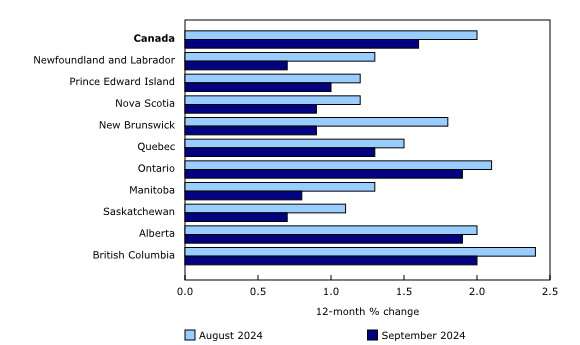Consumer Price Index, September 2024
Released: 2024-10-15
The Consumer Price Index (CPI) rose 1.6% on a year-over-year basis in September, down from a 2.0% gain in August. This was the smallest yearly increase since February 2021 (+1.1%). The main contributor to headline deceleration was lower year-over-year prices for gasoline in September (-10.7%) compared with August (-5.1%). The all-items CPI excluding gasoline rose 2.2% in September, matching the increase in August for this measure.
Although the rate at which prices are increasing has slowed, price levels remain elevated. Compared with September 2021, the CPI rose 12.7% in September. Canadians continue to feel the impact of higher price levels for day-to-day basics such as rent (+21.0%) and food purchased from stores (+20.7%), which increased during that same 3-year period.
On a monthly basis, the CPI fell 0.4% in September, after a 0.2% decline in August. Both the monthly and yearly movement in September were led by lower prices for gasoline. On a seasonally adjusted monthly basis, the CPI was unchanged at 0.0% in September.
Gasoline prices fall
Year over year, gasoline prices fell to a greater extent in September (-10.7%) compared with August (-5.1%), putting downward pressure on the all-items CPI.
On a monthly basis, gasoline prices fell 7.1% in September following a 2.6% decline in August. The September decline was driven by lower crude oil prices amid increasing concerns over weaker economic growth, as well as lower costs associated with switching to winter blends.
Similarly, prices for fuel oil and other fuels fell 22.0% year over year in September, after decreasing 10.2% in August.
Prices for rent increase at a slower pace
Prices for rent increased at a slower pace in September, rising 8.2% year over year, following an 8.9% gain in August. Rent price growth slowed the most in Newfoundland and Labrador (+5.1%), New Brunswick (+10.1%) and British Columbia (+7.3%).
Consumers pay less for air transportation
Consumers paid less on a year-over-year basis for air transportation (-4.4%) in September. Month over month, prices for air transportation fell 14.3%. This price movement is seasonally typical, as the month of September coincides with the end of the summer travel period.
Canadians continue to face higher prices at the grocery store
Prices for food purchased from stores rose 2.4% in September, the same growth rate as in August. This is the second consecutive month that grocery prices increased at a faster pace than headline inflation. While prices declined on a year-over-year basis for some food items, such as seafood and other marine products (-4.9%), nuts and seeds (-0.9%), and fish (-0.3%), others continued to increase and remained elevated, such as fresh or frozen beef (+9.2%), edible fats and oils (+7.8%) and eggs (+5.0%).
Additionally, prices for food purchased from restaurants rose at a slightly faster pace in September (+3.5%) compared with August (+3.4%).
Explore the Consumer Price Index tools
Check out Statistics Canada's Food Price Data Hub, which features a variety of food price related statistics, articles and tools.
Check out the Personal Inflation Calculator. This interactive calculator allows you to enter dollar amounts in the common expense categories to produce a personalized inflation rate, which you can compare to the official measure of inflation for the average Canadian household—the Consumer Price Index (CPI).
Browse the Consumer Price Index Data Visualization Tool to access current (Latest Snapshot of the CPI) and historical (Price trends: 1914 to today) CPI data in a customizable visual format.
Regional highlights
Year over year, prices rose at a slower pace in September compared with August in all provinces.
Tuition fees increase at a slower pace
Tuition fees, priced annually in September, rose at a slower pace in 2024 (+1.8%) compared with 2023 (+2.5%). Tuition fees increased 2.3% in Alberta, down from a 4.8% gain in September 2023, following a cap on domestic tuition fee increases.
Did you know we have a mobile app?
Download our mobile app and get timely access to data at your fingertips! The StatsCAN app is available for free on the App Store and on Google Play.
Note to readers
Visit the Consumer Price Index portal to find all Consumer Price Index (CPI) data, publications, interactive tools, and announcements highlighting new products and upcoming changes to the CPI in one convenient location.
Real-time data tables
Real-time data table 18-10-0259-01 will be updated on October 28. For more information, consult the document, "Real-time data tables."
Next release
The Consumer Price Index for October will be released on November 19.
Products
The "Consumer Price Index Data Visualization Tool" is available on the Statistics Canada website.
More information on the concepts and use of the Consumer Price Index (CPI) is available in The Canadian Consumer Price Index Reference Paper (62-553-X).
For information on the history of the CPI in Canada, consult the publication Exploring the first century of Canada's Consumer Price Index (62-604-X).
Two videos, "An Overview of Canada's Consumer Price Index (CPI)" and "The Consumer Price Index (CPI) and Your Experience of Price Change," are available on Statistics Canada's YouTube channel.
The podcast ''Eh Sayers Episode 18 - Why Food Inflation Is Such A Hard Nut To Crack'' is also available.
Find out answers to the most common questions posed about the CPI in the context of the COVID-19 pandemic and beyond.
Contact information
For more information, or to enquire about the concepts, methods or data quality of this release, contact us (toll-free 1-800-263-1136; 514-283-8300; infostats@statcan.gc.ca) or Media Relations (statcan.mediahotline-ligneinfomedias.statcan@statcan.gc.ca).
- Date modified:







